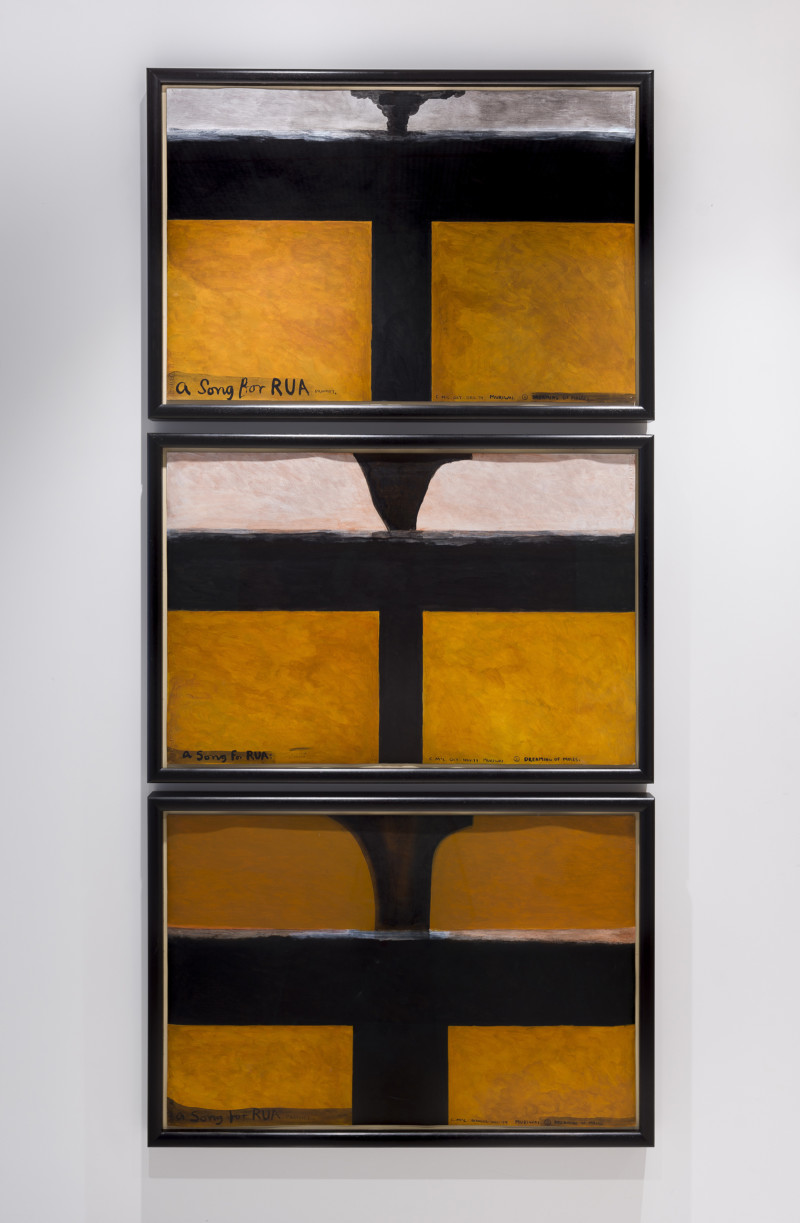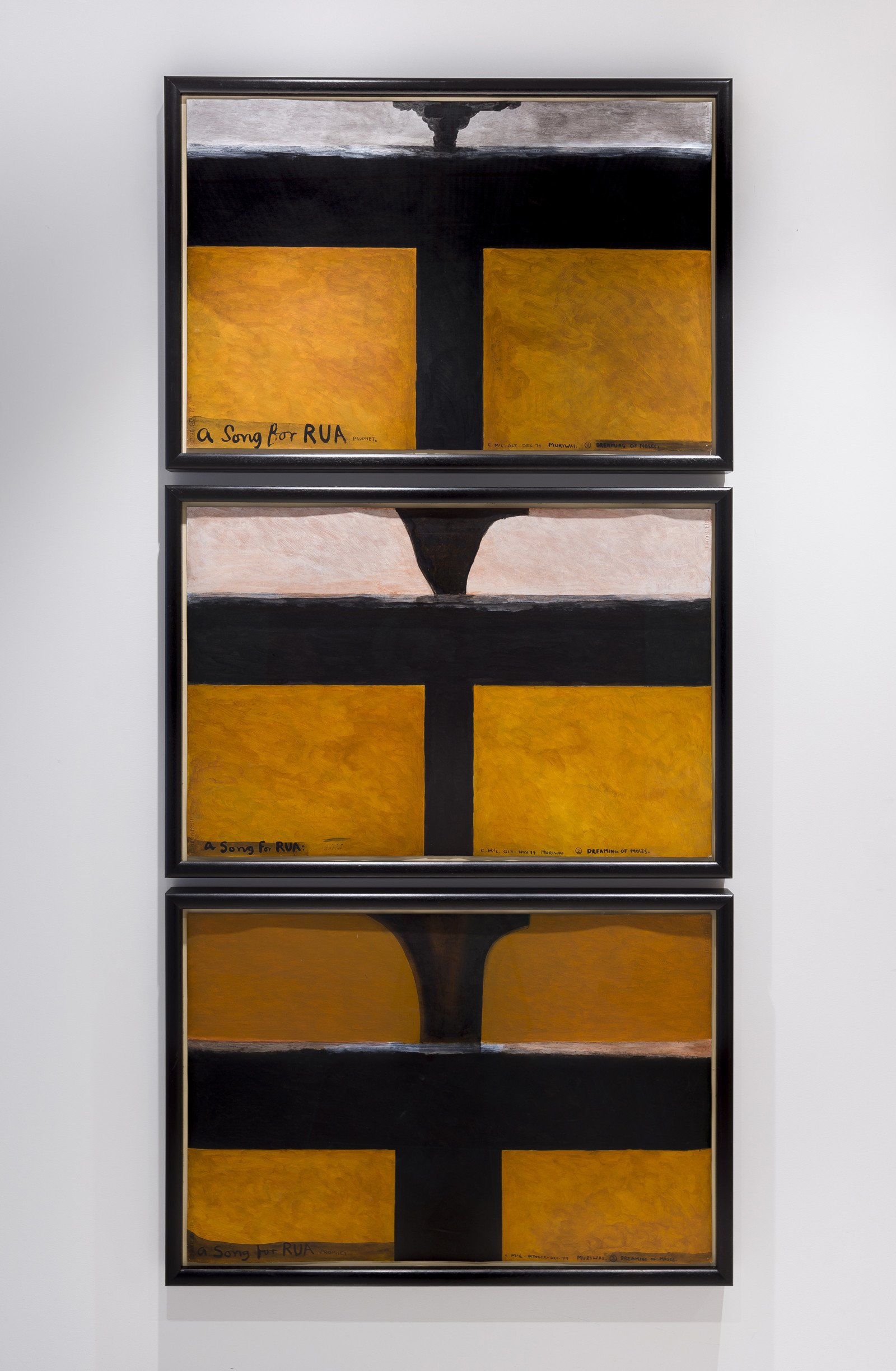MCCAHON, Colin;
A Song for Rua, Prophet (triptych)
1979
Acrylic on paper
3 pieces; 775 x 1000mm (each piece)

cm000378 on the Colin McCahon Online Catalogue.
The following two texts were written for Te Huringa/Turning Points and reflect the curatorial approach taken for that exhibition.
Peter Shaw
In late 1979, Colin McCahon began work on a three-part painting taking as its subject the Tūhoe messianic prophet Rua Kēnana. He gave each painting the subtitle Dreaming of Moses. The main image of each work is a black cross derived from the Greek letter Tau, which also represents a gate or opening. Along the top of the edge of the crossbar is a flat landscape above which appears a dark pillar of cloud. The Tau grows larger and nearer as the three paintings progress downwards in sequence, according to the vertical hanging scheme drawn by McCahon on one of the sheets of paper.
A passage in the Book of Exodus states, ‘When Pharaoh let the people go, God did not lead them on the road through the Philistine country, though that was shorter. … [Instead, He] led the people around by the desert road toward the Red Sea. … By day the Lord went ahead of them in a pillar of cloud to guide them on their way.’ The analogy between Moses’ leadership of the Israelites out of Egypt and Rua’s of the Tūhoe people from colonial oppression is clear. That Rua did not fully succeed is perhaps inferred by his state of ‘dreaming’ of Moses.
Gordon Brown has written, ‘McCahon sees the Māori situation as being integrated into a broader spiritual history where all share in the common events of human existence and where light and shade, life and death weave their eternal pattern upon humanity.’
Jo Diamond
This work demonstrates the convergence of an individual artist’s spiritual exploration and a Māori millennial movement of the late 19th century. The title of this painting holds the key to its multi-layered content and form. Its earthy palette, though contributing to the abstract form of the painting, clearly resonates with references to land, though the dominant dark cruciform shape provides at least a hint of a spiritual concept applied to the landscape. It is, however, the title that asserts the painting’s Māori ‘layer’.
The word ‘Rua’, to those familiar with social and religious history in Aotearoa, will be instantly recognisable as a Māori name as well as a number (two). It provides ample opportunity for wordplay, if not metaphor. It is the name of the prophet Rua Kēnana, whose religious order was based on the earlier work of Te Kooti Arikirangi Te Tūruki, founder of the Ringatū faith. Rua’s movement, centred in the small but vibrant community of Maungapōhatu, in the rugged Urewera mountain range, was millennial in that it sought a viable alternative to the religious and social order proffered by Pākehā Christian missionary efforts of the late 19th century. A Māori ‘Moses-like’ exodus from the ‘Egypt’ imposed by New Zealand’s colonialist government provided powerful symbolic motivation for the Christian and Māori ideals of Rua’s order.
This large-scale work pays a multi-layered homage. It acknowledges Rua’s leadership in the face of great challenge and eventual belligerence from colonial forces. Given McCahon’s many Old Testament-based explorations, it is also entirely feasible that Rua is employed in this work to ‘speak’ for more than Māori political concerns. Clearly, in the artist’s mind, Rua represents human spirituality, of which Māori sensibilities are only a part. The work is about the recognition of human spiritual need, symbolised in one word: the name of a Māori prophet. Rua’s ‘song’ comes to all of us in relation to our spiritual investment in land, and perhaps its final chorus asks not only for freedom from oppression, but also for justice and peace.
Exhibition History
Colin McCahon: A Journey, Gow Langsford, Onehunga, Tāmaki Makaurau, 23 November 2024 to 25 January 2025
Colin McCahon: On Going Out with the Tide, City Gallery Wellington Te Whare Toi, Te Whanganui-a-Tara, 8 April to 30 July 2017
Te Huringa/Turning Points: Pākehā Colonisation and Māori Empowerment, Sarjeant Gallery Te Whare o Rehua, Whanganui, 8 April to 16 July 2006 (toured)
McCahon: A View from Urewera, City Gallery Wellington Te Whare Toi, Te Whanganui-a-Tara, 6 November 1999 to 13 January 2000
Colin McCahon New Works, Peter Webb Gallery, Tāmaki Makaurau, 18 February to 7 March 1980
References
Justin Paton, McCahon Country (Tāmaki Makaurau: Penguin Books and Auckland Art Gallery Toi o Tāmaki, 2019), 258.
Peter Simpson, Colin McCahon: Is This the Promised Land?, Vol. 2 1960–1987 (Tāmaki Makaurau: Auckland University Press, 2020), 321.
Provenance
?
Fletcher Trust Collection, purchased from Webb’s, Tāmaki Makaurau

